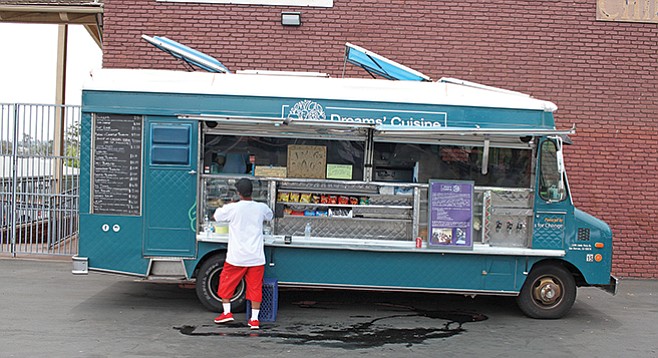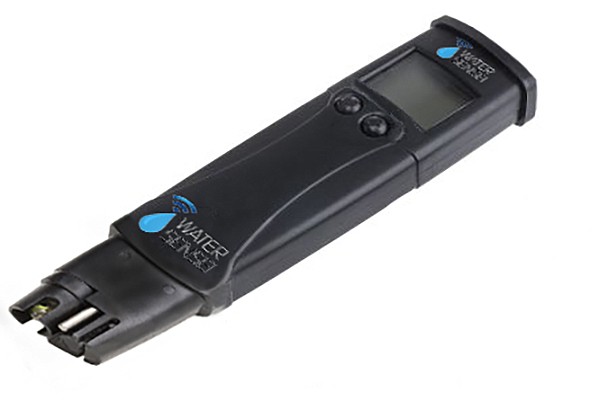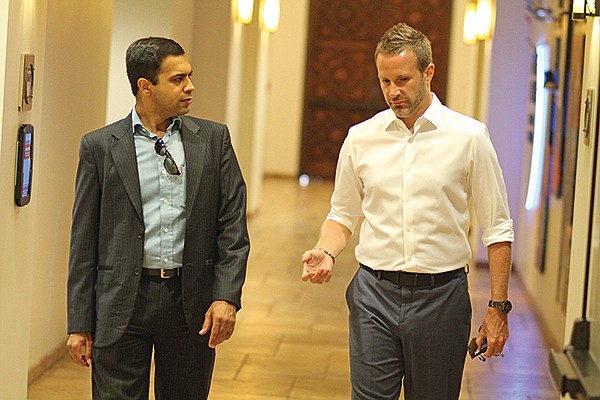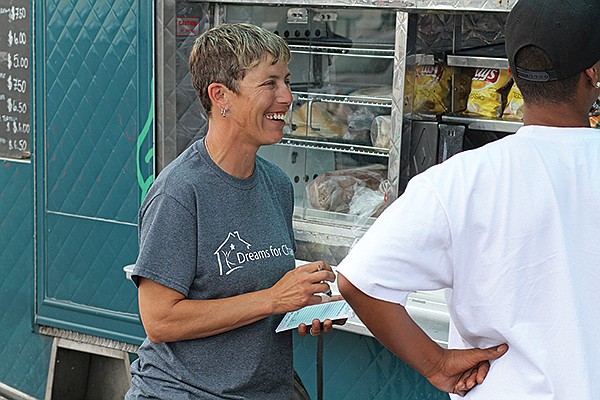 Facebook
Facebook
 X
X
 Instagram
Instagram
 TikTok
TikTok
 Youtube
Youtube

‘You just drop it into the back of your toilet tank,” explains David Vesay. “From there, it’s continually monitoring your water quality and you’ll get a message on your phone if it ever detects any issues.”

Vesay was part of a team of aspiring entrepreneurs getting ready to promote Water Sensei, his entry in the University of San Diego’s Global Social Innovation Challenge, when we first spoke in mid-June.

“Water quality issues are worldwide. Even here in San Diego, since I’ve been following this over the last year and a half it seems that nearly every week we’re seeing an alert from somewhere,” he continues. “We’re trying to build a map of water quality data around the world, and to share that information with everyone.”

Water Sensei is one of two USD finalists, culled from a field of 40 applicants, that was tapped to present at the challenge, held on the campus in late June. A total of 43 teams from 27 universities around the world were in town to pitch their business models designed around solving some sort of social, environmental, or economic justice issue. Top projects left the event with a share of $47,000 in seed money or in-kind services such as web development or professional mentoring to continue developing their startups.
“As part of the university’s Catholic identity, we want to encourage our students to think beyond themselves, to not limit their definition of success to personally doing well but thinking more about having a positive impact on the world,” says Dr. Amit Kakkad, director of USD’s Center for Peace and Commerce. “The thinking was that we wanted to give students a place not just to talk about this, but to practice these ideals before they go out into the world.”
What the contest doesn’t want, though, are business models that rely on charitable contributions or government grant money to fund the good work they aspire to complete. Kakkad is a professor at the university’s school of business and designed the challenge, now in its eighth year, as an incubator for businesses designed to generate enough revenue to be self-sustaining.
“We’ve kept the topic focus open to ensure the students are picking an issue they’re personally passionate about. We provide resources including mentors and coaches, workshops, and ultimately seed funding to the most promising ideas,” Kakkad continues. “The overarching goals are to support students’ entrepreneurial drive, channel that into what can be positive for the world, and along the way give them tools to create positive impacts in their future careers.”
All of the teams are composed strictly of volunteers — no class credit is awarded for participation, and entrants aren’t assured they’ll even get to pitch their ideas to judges at the actual competition. Of the 40 entries Kakkad says were submitted at USD in February, only 22 were given a green light to develop expanded business plans. While 19 of the groups got that far, only two were selected for participation in the challenge.
Meanwhile, similar mini-competitions were taking place across town at San Diego State, UC San Diego, the NewSchool of Architecture and Design, and across the country at places such as Duke and the University of Kentucky. International entries came from places such as Trinity College of Dublin, Universidad del Pacifico in Peru, and Uganda Christian University.
Back at Water Sensei the group honed its pitch, focusing on both the business model and the ecological impact it hoped to make.
“We want to do kind of a subscription model, every year we’re going to add more sensors to the device,” Vesay tells me, saying his initial target customer is someone in a developed nation who’s well off enough to drop $99 on a basic monitor that will tell you whether or not you’ve got an abnormally high amount of dissolved solids in your tap water and whether you should consider further lab analysis.
“A big problem with sustainability in electronics like smartphones is that once you’ve got the ‘old version’ and a new one’s available you tend to just throw the old device away,” he continues. “We want to buy back those devices by offering a discount on the update. Then we’ll get those devices back and distribute them in developing countries where people can’t afford them.”
As the tech industry continues to evolve, Vesay envisions newer generation sensors will be able to detect specific minerals, like the lead that sparked the recent water crisis in Flint, Michigan. The more wealthy customers he finds willing to splurge on upgrades, the more devices he’ll then get back to refurbish and distribute to developing countries that otherwise wouldn’t be able to afford the technology, while still turning enough profit through new sales and updates to keep the business viable.
That’s not all — the internet connectivity of Water Sensei means that its reach goes beyond the customers. With just a handful of sensors active in a neighborhood, enough data could be gleaned to map out water quality broadly across a region. And since the sensors give a new reading with every flush, the long-term results offer a more comprehensive look at the water system than single-use tests that only examine a single data point.
The reach of a project, however, doesn’t have to be global.
“It was the heart of the recession, and at the time I was working with another non-profit on anti-poverty campaigns, including one that provided hotel vouchers for the homeless,” recalls Dr. Teresa Smith, founder of the local nonprofit Dreams For Change. “We started seeing a new kind of face coming to us that were homeless, not our typical generational poverty. So we sent them down to the shelters, because that was our avenue for aid, and they’d come back and say ‘Oh my goodness, I can’t do that. I just lost my job, lost my home, but I’ve always had money and been generally stable. I don’t want to expose my family to that environment, I’d rather stay in my car.’ That was a theme we were hearing over and over again.”
Smith was working with Kakkad’s Center for Peace and Commerce to establish her group’s Safe Parking Program, which provides a secure overnight space for people living in their vehicles, when she learned about the challenge in its early days.
“We were hearing from our clients that they were spending their day chasing food, which was preventing them from looking for a job or accessing other resources.”
This problem inspired Dreams for Change to try branching out from her model of securing city parking lots for overnight stays.
“We landed on this food truck concept — let’s get a food truck on the road, we can take it to where the homeless are going to be and they can use their benefit cards to purchase food.
“I was hesitant to enter at first, because I thought the program was for big, global projects, and this one had just a small, local focus,” she remembered, though the group entered anyway and used the $10,000 they won in seed funding to buy their first truck.
Now, there are three trucks on the road, including one focused on serving fixed-income seniors in the North County area.
“It’s like your standard taco truck. We wanted to bring human dignity to the process; often when people would roll up in their cars and offer handouts it was just mass chaos, there’s no dignity or choice in that. Our goal was to make it just like any other experience in everyday life, but with healthier options and a cheaper price. People can buy what they want, whether it’s a chicken burrito or a salad.
“We run what we call a double bottom line, because in addition to the food service component there’s a work training element. All our trucks are run by trainees that we’re helping to develop some soft skills. Most are just coming out of the prison system, or they’re youth in the 18-24 age range who’ve never had work opportunities, work on the trucks and in classes we conduct gets them trained and employable.”
Smith says her workers stay on the trucks for an average of three months, clocking a minimum of 175 paid hours and attending at least a dozen classes in addition to one-on-one case manager sessions. Sixty-five people went through the program last year, and according to Smith 70 percent either found permanent employment or went back to school after graduating.
After months of preparation, most of the student teams gathered at USD on June 23rd for a full day of presentations and pitches. A few that were unable to travel pitch remotely via video conference.
By five in the afternoon the field has been narrowed to ten finalists. Neither Water Sensei nor any of the other entries from San Diego schools make the cut, which will allow them one last chance to pitch before awards are announced. An entry from CETYS Universidad in Tijuana, however, is included — their proposal to convert household waste into energy using digester systems nets a $1500 second-prize award in the Women Innovators category, one of three secondary prizes awarded alongside the primary category.
The $15,000 grand prize winner is Team Charcoal, a group from Ghana working to convert human waste into organic charcoal to both reduce health hazards and provide energy in developing nations. They’re topped only by Keep Appy, a mental health and wellness smartphone app developed by an Irish team — the project raised $17,500 by taking first place in all three subdivisions and second place in the main competition.
Though Water Sensei doesn’t receive a cash payout, the project is one of a host of participants receiving in-kind prizes, and Vesay says his group is committed to bringing their project to life. “Although it’s disappointing not to have gotten farther it’s a relief to have this behind us so we can work on further steps,” Vesay tells me in the days after the event. “We are still very much committed to this project and have much work to do.”


‘You just drop it into the back of your toilet tank,” explains David Vesay. “From there, it’s continually monitoring your water quality and you’ll get a message on your phone if it ever detects any issues.”

Vesay was part of a team of aspiring entrepreneurs getting ready to promote Water Sensei, his entry in the University of San Diego’s Global Social Innovation Challenge, when we first spoke in mid-June.

“Water quality issues are worldwide. Even here in San Diego, since I’ve been following this over the last year and a half it seems that nearly every week we’re seeing an alert from somewhere,” he continues. “We’re trying to build a map of water quality data around the world, and to share that information with everyone.”

Water Sensei is one of two USD finalists, culled from a field of 40 applicants, that was tapped to present at the challenge, held on the campus in late June. A total of 43 teams from 27 universities around the world were in town to pitch their business models designed around solving some sort of social, environmental, or economic justice issue. Top projects left the event with a share of $47,000 in seed money or in-kind services such as web development or professional mentoring to continue developing their startups.
“As part of the university’s Catholic identity, we want to encourage our students to think beyond themselves, to not limit their definition of success to personally doing well but thinking more about having a positive impact on the world,” says Dr. Amit Kakkad, director of USD’s Center for Peace and Commerce. “The thinking was that we wanted to give students a place not just to talk about this, but to practice these ideals before they go out into the world.”
What the contest doesn’t want, though, are business models that rely on charitable contributions or government grant money to fund the good work they aspire to complete. Kakkad is a professor at the university’s school of business and designed the challenge, now in its eighth year, as an incubator for businesses designed to generate enough revenue to be self-sustaining.
“We’ve kept the topic focus open to ensure the students are picking an issue they’re personally passionate about. We provide resources including mentors and coaches, workshops, and ultimately seed funding to the most promising ideas,” Kakkad continues. “The overarching goals are to support students’ entrepreneurial drive, channel that into what can be positive for the world, and along the way give them tools to create positive impacts in their future careers.”
All of the teams are composed strictly of volunteers — no class credit is awarded for participation, and entrants aren’t assured they’ll even get to pitch their ideas to judges at the actual competition. Of the 40 entries Kakkad says were submitted at USD in February, only 22 were given a green light to develop expanded business plans. While 19 of the groups got that far, only two were selected for participation in the challenge.
Meanwhile, similar mini-competitions were taking place across town at San Diego State, UC San Diego, the NewSchool of Architecture and Design, and across the country at places such as Duke and the University of Kentucky. International entries came from places such as Trinity College of Dublin, Universidad del Pacifico in Peru, and Uganda Christian University.
Back at Water Sensei the group honed its pitch, focusing on both the business model and the ecological impact it hoped to make.
“We want to do kind of a subscription model, every year we’re going to add more sensors to the device,” Vesay tells me, saying his initial target customer is someone in a developed nation who’s well off enough to drop $99 on a basic monitor that will tell you whether or not you’ve got an abnormally high amount of dissolved solids in your tap water and whether you should consider further lab analysis.
“A big problem with sustainability in electronics like smartphones is that once you’ve got the ‘old version’ and a new one’s available you tend to just throw the old device away,” he continues. “We want to buy back those devices by offering a discount on the update. Then we’ll get those devices back and distribute them in developing countries where people can’t afford them.”
As the tech industry continues to evolve, Vesay envisions newer generation sensors will be able to detect specific minerals, like the lead that sparked the recent water crisis in Flint, Michigan. The more wealthy customers he finds willing to splurge on upgrades, the more devices he’ll then get back to refurbish and distribute to developing countries that otherwise wouldn’t be able to afford the technology, while still turning enough profit through new sales and updates to keep the business viable.
That’s not all — the internet connectivity of Water Sensei means that its reach goes beyond the customers. With just a handful of sensors active in a neighborhood, enough data could be gleaned to map out water quality broadly across a region. And since the sensors give a new reading with every flush, the long-term results offer a more comprehensive look at the water system than single-use tests that only examine a single data point.
The reach of a project, however, doesn’t have to be global.
“It was the heart of the recession, and at the time I was working with another non-profit on anti-poverty campaigns, including one that provided hotel vouchers for the homeless,” recalls Dr. Teresa Smith, founder of the local nonprofit Dreams For Change. “We started seeing a new kind of face coming to us that were homeless, not our typical generational poverty. So we sent them down to the shelters, because that was our avenue for aid, and they’d come back and say ‘Oh my goodness, I can’t do that. I just lost my job, lost my home, but I’ve always had money and been generally stable. I don’t want to expose my family to that environment, I’d rather stay in my car.’ That was a theme we were hearing over and over again.”
Smith was working with Kakkad’s Center for Peace and Commerce to establish her group’s Safe Parking Program, which provides a secure overnight space for people living in their vehicles, when she learned about the challenge in its early days.
“We were hearing from our clients that they were spending their day chasing food, which was preventing them from looking for a job or accessing other resources.”
This problem inspired Dreams for Change to try branching out from her model of securing city parking lots for overnight stays.
“We landed on this food truck concept — let’s get a food truck on the road, we can take it to where the homeless are going to be and they can use their benefit cards to purchase food.
“I was hesitant to enter at first, because I thought the program was for big, global projects, and this one had just a small, local focus,” she remembered, though the group entered anyway and used the $10,000 they won in seed funding to buy their first truck.
Now, there are three trucks on the road, including one focused on serving fixed-income seniors in the North County area.
“It’s like your standard taco truck. We wanted to bring human dignity to the process; often when people would roll up in their cars and offer handouts it was just mass chaos, there’s no dignity or choice in that. Our goal was to make it just like any other experience in everyday life, but with healthier options and a cheaper price. People can buy what they want, whether it’s a chicken burrito or a salad.
“We run what we call a double bottom line, because in addition to the food service component there’s a work training element. All our trucks are run by trainees that we’re helping to develop some soft skills. Most are just coming out of the prison system, or they’re youth in the 18-24 age range who’ve never had work opportunities, work on the trucks and in classes we conduct gets them trained and employable.”
Smith says her workers stay on the trucks for an average of three months, clocking a minimum of 175 paid hours and attending at least a dozen classes in addition to one-on-one case manager sessions. Sixty-five people went through the program last year, and according to Smith 70 percent either found permanent employment or went back to school after graduating.
After months of preparation, most of the student teams gathered at USD on June 23rd for a full day of presentations and pitches. A few that were unable to travel pitch remotely via video conference.
By five in the afternoon the field has been narrowed to ten finalists. Neither Water Sensei nor any of the other entries from San Diego schools make the cut, which will allow them one last chance to pitch before awards are announced. An entry from CETYS Universidad in Tijuana, however, is included — their proposal to convert household waste into energy using digester systems nets a $1500 second-prize award in the Women Innovators category, one of three secondary prizes awarded alongside the primary category.
The $15,000 grand prize winner is Team Charcoal, a group from Ghana working to convert human waste into organic charcoal to both reduce health hazards and provide energy in developing nations. They’re topped only by Keep Appy, a mental health and wellness smartphone app developed by an Irish team — the project raised $17,500 by taking first place in all three subdivisions and second place in the main competition.
Though Water Sensei doesn’t receive a cash payout, the project is one of a host of participants receiving in-kind prizes, and Vesay says his group is committed to bringing their project to life. “Although it’s disappointing not to have gotten farther it’s a relief to have this behind us so we can work on further steps,” Vesay tells me in the days after the event. “We are still very much committed to this project and have much work to do.”
Comments